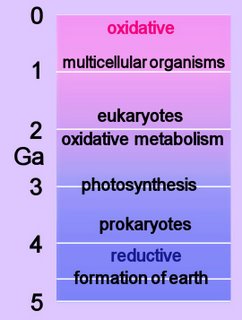Timeline Earth Life
Timeline for life in billions of years (Ga): click to enlarge image.

Based on radio-dating of meteorites, the solar system is about 4600 Ma – 4600 million years, or 4.6 billion years old (Ga). The formation of the earth occurred 10 Ga after the Big Bang. The sun and planets condensed from a large, hot accretion disk.
The earliest atmosphere of H2 and He was lost to space, and was replaced by a reductive atmosphere with a composition probably similar to outgassing of modern volcanoes – H2O, CO2, SO2, S2, Cl2, N2, NH3, and CH4.
Oxygen levels began to rise after the evolution of oxygenic photosynthesis by the Cyanobacteria, which evolved at least at least 3450 million years ago (3.45 Ga) and formed the earliest microfossils as stromatolite reefs.
There is considerable evidence that the earliest eukaryotes evolved through serial endosymbiosis. Chloroplasts resulted from endosymbiotic transfers of Cyanobacteria, and mitochondria originated from endosymbiotic transfers of alpha-proteobacteria (purple bacteria). Mitochondria are the site of oxidative phosporylation in eukaryotes.


Based on radio-dating of meteorites, the solar system is about 4600 Ma – 4600 million years, or 4.6 billion years old (Ga). The formation of the earth occurred 10 Ga after the Big Bang. The sun and planets condensed from a large, hot accretion disk.
The earliest atmosphere of H2 and He was lost to space, and was replaced by a reductive atmosphere with a composition probably similar to outgassing of modern volcanoes – H2O, CO2, SO2, S2, Cl2, N2, NH3, and CH4.
Oxygen levels began to rise after the evolution of oxygenic photosynthesis by the Cyanobacteria, which evolved at least at least 3450 million years ago (3.45 Ga) and formed the earliest microfossils as stromatolite reefs.
There is considerable evidence that the earliest eukaryotes evolved through serial endosymbiosis. Chloroplasts resulted from endosymbiotic transfers of Cyanobacteria, and mitochondria originated from endosymbiotic transfers of alpha-proteobacteria (purple bacteria). Mitochondria are the site of oxidative phosporylation in eukaryotes.
Labels: Cyanobacteria, early atmosphere, eukaryotes, outgassing, oxidative, oxidative phosporylation, oxygenic photosynthesis, prokaryotes, reductive, serial endosymbiosis, stromatolites
| 0 Guide-Glossary







































